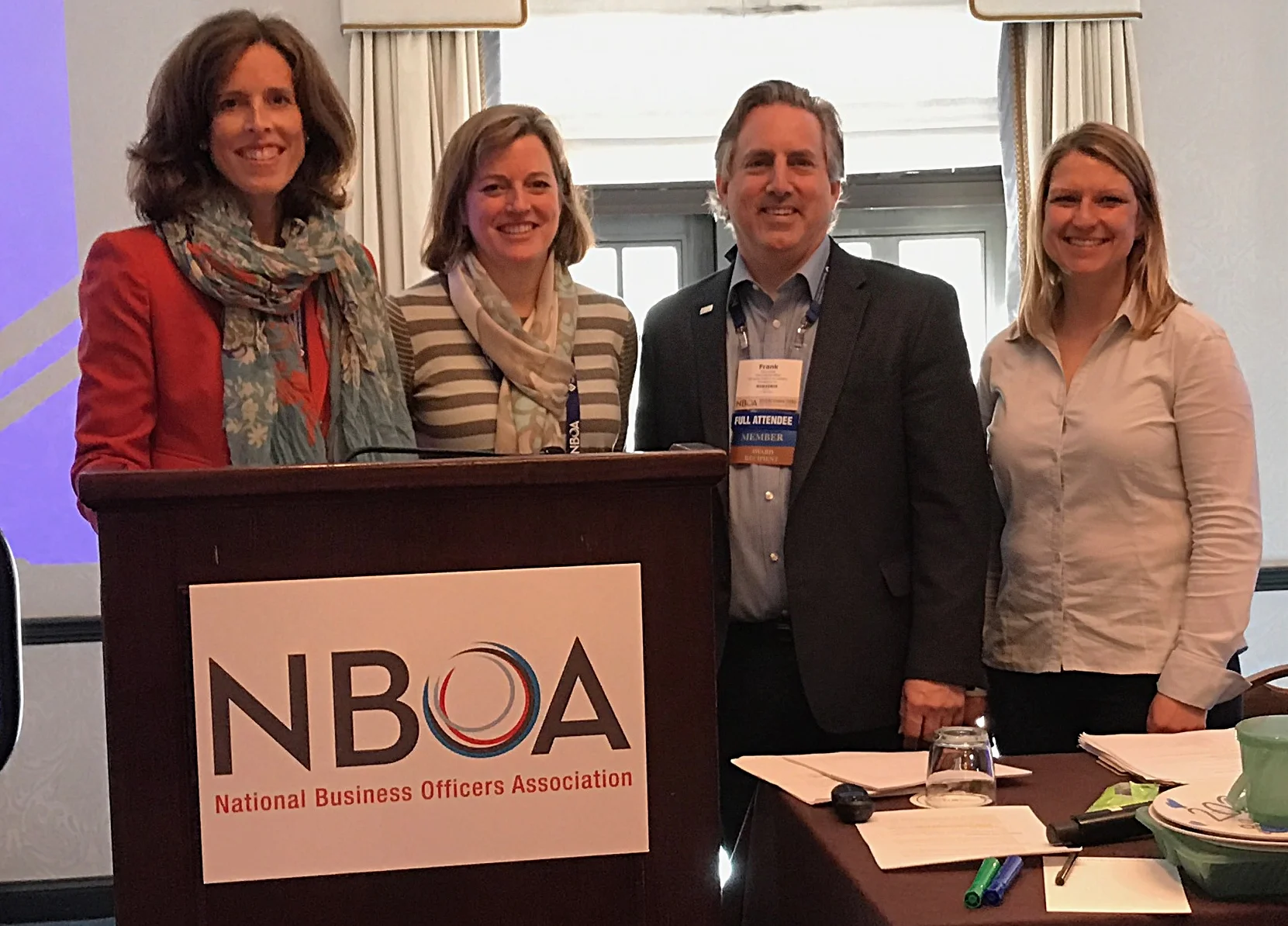Twenty-three educators, sustainability coordinators, and administrators from PAISBOA member schools gathered at The School in Rose Valley (SRV) for the PAISBOA Sustainability meeting, co-organized by PAISBOA and Boyer Sudduth Environmental Consultants (BSEC) on October 9th, 2025. This event provided a space for participants to share ideas, highlight campus initiatives, and strengthen connections around environmental sustainability.
2025-2026 Grants to Green Your School
Growing a Sustainable Culture in Our Schools: AIS Hosts the PAISBOA Sustainability Meeting
On Wednesday April 30th, more than 30 educators, sustainability coordinators, and facilities staff from PAISBOA member schools came together for the group’s semiannual sustainability meeting, co-organized by PAISBOA and Boyer Sudduth Environmental Consultants (BSEC). This spring’s gathering was hosted by The Agnes Irwin School (AIS) and offered a space to share ideas, explore campus initiatives, and build connections around school sustainability.
The Hidden Cost of Food Waste and How You Can Address it Locally
Every day, the average American produces 4.9 pounds of trash — a staggering amount that contributes to overflowing landfills and environmental harm. A significant portion of this waste comes from food. In fact, 30-40% of the U.S. food supply is wasted, the equivalent of bringing home three grocery bags and tossing one straight into the trash.
By making small changes, we can reduce waste, save money and help protect the planet. Let's make every day Earth Day, starting with what's on our plates.
From Ideas to Action: Students Present Sustainability Solutions to the School’s Administrative Team
At Abington Friends School (AFS), sustainability isn’t just a concept, it’s something that students are actively engaging with and exploring. Under the direction of Middle School science teacher Virginia Friedman, 7th-grade students took on a hands-on sustainability challenge: identifying areas where the school could reduce waste and become more environmentally responsible.
Sorting It Out: Abington Friends’ Waste Audit in Action
Did you know the average American produces nearly 5 pounds of waste per day (EPA, 2024)? Schools generate a significant amount of waste, from lunch trays to classroom materials, much of which could be diverted from landfills.
To better understand their impact, 7th Grade students at Abington Friends School conducted a waste audit, sorting and analyzing a school day’s worth of trash.
Brewing Sustainability: One Café’s Eco-Friendly Journey
At EB Coffee & Pub (EB), owner Justin Nichols and his team envision a vibrant community hub where every cup of coffee tells a story of quality, sustainability, and connection. From reducing waste with recyclable and reusable materials, to prioritizing local suppliers, and fostering partnerships with local community groups, the goal is to make sustainability an integral part of daily operations. EB Coffee & Pub demonstrates how small, local businesses can contribute to a sustainable future.
Case Study: Middlebury College’s Journey Towards a Carbon-Neutral Campus
Middlebury College has positioned itself as a leading environmentally-conscious institution and is one of the first colleges/universities in the world to achieve carbon neutrality. A core part of the college’s mission statement emphasizes “addressing the world’s most challenging problems” – a vision that the community has actively pursued through its deep commitment to environmentalism and sustainability. By creating a roadmap to achieve carbon neutrality by 2016, this vision has come to fruition, though the journey hasn’t always been easy.
Leave the Leaves: A Teachable Moment
Fallen leaves provide crucial winter protection for insects and invertebrates like butterflies, moths, and beetles. For example, wooly bear and great spangled fritillary caterpillars rely on leaves for warmth and food. By participating in the “Leave the Leaves” campaign, schools can support these ecosystems on their own grounds. Imagine designating a section of the schoolyard as a “wild zone” where leaves are left undisturbed, creating a living laboratory for students to observe changes throughout the seasons.
PAISBOA Sustainability Group Explores UN Sustainable Development Goals at Norwood-Fontbonne Academy
On October 17th, the PAISBOA Sustainability Group gathered at Norwood-Fontbonne Academy (NFA) for a meeting focused on integrating the United Nations Sustainable Development Goals (SDGs) into school curricula. Hosted by NFA's Media Science Teacher Megan Stotz, the session titled “Using United Nations Sustainable Development Goals in Your Curriculum” attracted representatives from eight PAISBOA member schools.
3 Ways You Can Reduce Your Environmental Footprint (podcast with Mary Ann)
Last month I sat down with Colleen Falicki, on her Speaking of Sustainability podcast, and Founder of Back to Earth Compost. We discussed 3 ways individuals can reduce their environmental footprint including reducing food waste. Here’s a link to the podcast.
2024-2025 School Grants
A Student’s Reflections on a Sustainable Way to Travel
Skidmore College Reimagines A Sustainable Landscape Plan
Skidmore College in Saratoga Springs, New York, is reimagining its campus grounds into a more sustainable one. After an 8 month long collaborative effort between Skidmore’s Sustainability Office, Skidmore’s Facilities Department, and a consulting group: The LA Group, a Sustainability Landscape Plan (SLP) was born. The SLP works in conjunction with two other informative Skidmore plans, the Campus Master Plan (2022) and the Sustainability Plan (2015-2025). The SLP helps pave a roadmap for future projects as the college continues to evolve.
“Creating Community Connections” AIM Academy Hosts Spring Sustainability Meeting
AIM Academy’s Jeff Fetterman stands next to a whiteboard drawing at a recent PAISBOA Sustainability Meeting with area schools. AIM hosted the event. “Here’s an example of how students can learn about bike geometry,” said Fetterman as he referred to a sketch of a bike with various arrows, labels, and angles. “Today, we studied the geometry of the bike design by comparing the old-style bikes to the new.” Check out the blog article to read more.
PAR Recycle Works: Jobs and Hope for the Future
People Advancing Reintegration (aka PAR Recycle Works) is a Philadelphia-based non-profit electronic waste (or e-waste) recycler that provides transitional employment to people returning from incarceration and reintegrating into the workforce. It is the perfect balance between important environmental goals and an equally key social mission.
2024 PAISBOA Sustainability Benchmarking Survey Results Are In
On March 6, PAISBOA Sustainability Group met virtually to review the Sustainability School Survey results, now in its third year. The survey aims to document the sustainability practices and progress among PAISBOA schools, and enables individual schools to see where they fall in comparison to peer institutions. PAISBOA’s Ron Hill and Boyer Sudduth’s Mary Ann Boyer and intern, Fernando Leon Rueda, shared the survey findings.
A Small School Tackles Big Changes: a Sustainable Renovation
Surrounded by 55 acres of lush green landscape, Dana Hall School is situated in the town of Wellesley, a suburb of Boston, MA. This independent boarding and day school for girls grades 5-12 is currently on an ambitious mission. Since July 2022, Dana Hall has been renovating their entire Upper School Building in a way that reflects their value for sustainability. Here is how this small school is tackling this big project.
Join the Team!
Eco-Schools USA: a Short Guide for Teachers & Administrators
Description
National Wildlife Federation’s Eco-Schools program is a free third-party certification program that uses school-based action teams of students, administrators, and educators to drive environmental stewardship and education in schools. Eco-Schools - USA has over 5,000 schools that are registered and internationally operates in over 60 countries. Schools can achieve four levels of certification: Bronze, Silver, Gold, and the internationally renowned Green Flag. Each level is based on the number of points a school achieves.
Certification Framework
Eco-Schools’ steps to achieve certification:
Authentically Engage the Community: Foster genuine connections both within and beyond the school environment, cultivating purposeful relationships.
Form an Action Team: Establish a student-led committee rooted in both the school and the community. Harness the group’s skills to drive environmentally-focused initiatives for the school community.
Develop an Action Plan: Develop a comprehensive plan outlining specific goals, actions, and timelines for improvement.
Take Action, Collect Data, and Measure Impact: Explore nature-based and community-driven solutions for addressing issues outlined in the team's action plan. Use accessible, fact-based storytelling to inform, raise awareness, and inspire action.
Monitor and Evaluate Progress: Gather information before and after to assess and measure the success of a school’s plan. Inform the school community about the progress and action results.
Identify Curricular Connections: Encourage curricular connections across disciplines.
Establish an Eco-Code and Celebrate: Acknowledge everyone who contributed and the remarkable positive influence on the school community. Create a code or framework for the future and showcase the school's achievement and celebrate!
Framework in Action
Once a school is registered, there are action steps to further a school’s sustainability goals that connect to the UN Sustainable Development Goals. On the Eco-School’s dashboard, there are points that a school must meet in order to achieve a specific level:
Credit: EcoSchools United States
Themes Addressed by Eco-Schools:
Eco-Schools addresses various environmental themes, allowing schools to tailor their sustainability efforts. These may include:
Waste Reduction: Strategies to minimize waste and promote recycling.
Energy Conservation: Initiatives to reduce energy consumption and increase efficiency.
Water Usage: Practices to conserve water resources within the school.
Biodiversity: Efforts to protect and enhance the diversity of plant and animal species.
Benefits of Eco-Schools
Environmental Impact: Schools contribute to a healthier planet by reducing their ecological footprint.
Educational Value: Students gain practical knowledge and skills related to sustainability.
Community Engagement: Eco-Schools foster a sense of environmental responsibility within the local community.
Point of Pride: Becoming an Eco-School has been a source of pride for many schools. This certification leads to more positive sustainable actions within a school community.
Getting Started
To embark on the Eco-Schools journey:
Register: Sign up for the Eco-Schools program to access resources and support.
Form Your Action Committee: Assemble a dedicated team passionate about sustainability.
Implement Action Plan: Begin making positive changes, one step at a time and record them in your action dashboard.
Submit your application! Applications are open from the first Friday in April to the first Friday in June. (Note: To register for the highest level, Green Flag, registration is due by January 26, 2024.)
Conclusion
Eco-Schools empowers educational institutions to become catalysts for positive environmental change. By putting the certification framework into action, forming dedicated Action Teams, addressing key themes, and embracing sustainability, schools can contribute to a greener and more sustainable future. For more information, see Eco-Schools-USA.
Article by Sarah Treacy, Sustainability Intern at Boyer Sudduth Environmental Consultants.
Article printed in PAISBOA’s Friday Flyer Vol . XIII, No. 1 - January 12, 2024






























